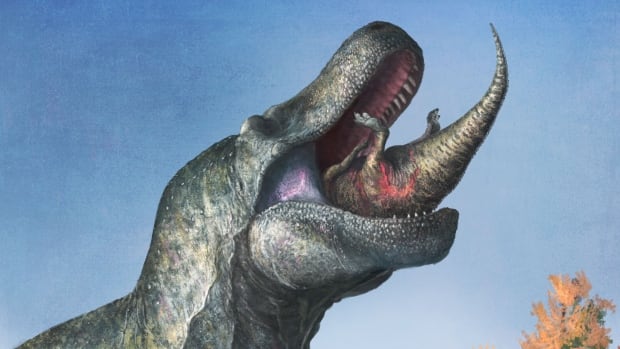An international team of paleontologists has found evidence that may change the modern understandings of the Tyrannosaurus rex and velociraptor.
A paper published in the journal Science released on Thursday says new evidence suggests that instead of large, exposed teeth, the dinosaur species actually had lips enclosing their mouths.
This discovery is a significant step in uncovering a more accurate picture of creatures that lived more than 66 million years ago and could change reconstructions and depictions of dinosaurs in the future, according to experts in the field.
Derek Larson, a co-author of the paper and a paleontologist at the Royal B.C. Museum, said that the dinosaurs’ lips were not the “kissing lips” seen on mammals today. They were likely less dexterous and more similar to the lips of modern lizards.
For a long time, theropod dinosaurs such as the T. rex were considered to have exposed teeth, similar to modern crocodiles, thought to be too large to be contained behind the lips.
Gavin Bradley, a paleontologist from the University of Alberta who isn’t involved with the paper, said that they were considered to have exposed teeth — similar to one of their closest living relatives, the modern crocodile.
“When we were trying to reconstruct the physiology or behaviour of dinosaurs, we often looked at their closest living relatives, so that would be crocodiles or birds…but crocodiles don’t have lips,” he said.
This has influenced popular depictions of the T. rex in artist renderings and films, including Jurassic Park, said Thomas Cullen, the study’s lead author and an assistant professor at Auburn University in Alabama.
“I think this is another piece in that puzzle of getting people to think of these animals as just that, as animals and not necessarily as movie monsters,” he said.
Uncovering the evidence
Cullen says he first began looking into evidence of lips on theropods about a decade ago when he worked at the University of Toronto, alongside other paleontologists, including Larson, at the university and Royal Ontario Museum. It started as a side project, born from speculation about whether it was possible to prove the existence of parts of dinosaurs — such as lips — that may have been lost to time.
“The soft tissues have all decayed away, so we are left with indirect forms of evidence,” said Larson.
In their search for evidence of lips, the researchers took two approaches: examining the wear patterns on T. rex tooth enamel and comparing its jaw and tooth proportions to modern lizards.
They found that the T. rex had equal tooth enamel thickness, which was more consistent with teeth that are constantly hydrated inside a mouth than the uneven enamel on exposed crocodile teeth.
When comparing the tooth and skull proportions to modern monitor lizards, the team also discovered that the T. rex had typically sized teeth for a predator of its size — and some modern lizards with lips actually had larger teeth compared to their skull size.
Cullen says this evidence came in around the same time in 2017 and was the first significant push that allowed them to start becoming confident in the existence of lips.
New findings open up new avenues of study
Larson is looking forward to hearing what Canadians and the paleontology community have to say about these findings.
“It’s very exciting to make discoveries like this … and to finally bring them to light so that other members of the public and other scientists can see our work and evaluate that,” he said.

François Therrien, a curator at the Royal Tyrrell Museum of Palaeontology in Drumheller, Alta., says that the depiction of the T. rex as a toothy, killing machine came from a time when paleontologists first uncovered dinosaur bones and were in awe of their frightening appearance.
However, he notes that even a domestic cat’s skeleton could look fierce on its own.
“[Cats] have big canines [and] big sharp teeth, but once you put all the flesh on the muscles and the fur on top, then there are those cute little pets that you want to play with.
“Not that I’m saying that, basically, dinosaurs would have been good pets, but they would probably not have been as scary as what their bones seem to tell us,” Therrien said.
Bradley said that this discovery could change reconstructions and depictions of dinosaurs going forward.
“For years, we’ve always had that big picture of Tyrannosaurus rex with those steak-knife-like teeth out in the open, showing us its toothy grin,” he said. “If people are keeping up to date on this research when we’re doing those reconstructions in the media and books and things like that, you might see those teeth begin to be covered up.”
One of the specimens the research team used in this study was a Field-Museum-of-Natural-History T. rex nicknamed Sue, the largest T. rex ever uncovered.
Canadians can see Sue’s teeth and skull at the Royal B.C. Museum in a travelling exhibit that will open on June 16.
In recent years, Therrien says research has shifted from investigating the genetics of dinosaurs to discerning their appearance, including the discovery that they may have been covered in feathers.
Even for creatures that last walked the Earth millions of years ago, Cullen expects there is still more to learn about the appearance of dinosaurs. He plans to look next at the thickness of T. rex’s gums compared to modern lizards.


